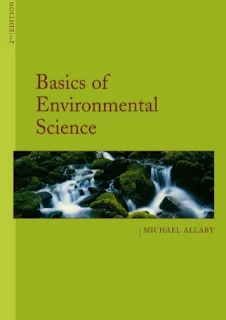 |
| Basics of Environmental Science by Michael Allaby |
About the Book:
- Introduction
to Environmental Science: The book likely starts with an
introduction to the field of environmental science, explaining its importance,
scope, and the interdisciplinary nature of the discipline.
- Ecology:
Ecology is often a fundamental component of environmental science. This section
would cover topics like ecosystems, biodiversity, population dynamics, and the
relationships between organisms and their environments.
- Atmosphere
and Climate: Environmental science often explores the
Earth's atmosphere, weather patterns, climate change, and the impact of human
activities on the climate.
- Geology
and Land Use: Understanding the Earth's geological
processes, landforms, and how humans use and modify land are crucial aspects of
environmental science.
- Water
Resources: This section typically covers topics such as the
hydrological cycle, water quality, water pollution, and the management of water
resources.
- Environmental
Pollution: Environmental science often addresses various types of
pollution, including air pollution, water pollution, soil contamination, and
noise pollution. It may also discuss the sources and effects of pollution.
- Waste
Management: Managing waste, including solid waste, hazardous waste,
and electronic waste, is an important aspect of environmental science. The book
may discuss waste disposal methods, recycling, and the environmental impact of
different waste management practices.
- Energy
and Sustainability: Exploring energy sources, conservation, and
sustainable practices is crucial for understanding environmental science. This
section may cover renewable energy, fossil fuels, and energy efficiency.
- Conservation
and Natural Resource Management: Environmental scientists
often focus on the conservation of natural resources, including forests,
fisheries, and wildlife. This section may discuss conservation strategies and
sustainable resource management.
- Environmental
Policy and Ethics: Understanding the policies and regulations
related to environmental protection, as well as ethical considerations, is
important for environmental scientists and policymakers.
- Human
Population and Environmental Impact: This section may explore how
human population growth and consumption patterns affect the environment and
natural resources.
- Environmental
Challenges and Solutions: The book may discuss contemporary
environmental challenges, such as climate change, deforestation, species
extinction, and offer potential solutions.
- Case
Studies: Many environmental science books include real-world case
studies and examples to illustrate key concepts and demonstrate how scientific
principles are applied in practice.
Michael Allaby's book is
likely to provide a comprehensive overview of these topics, making it a
valuable resource for students and individuals interested in environmental
science. Keep in mind that the content and organization of the book may vary
depending on the edition and publisher. For the most detailed and up-to-date
information, it's best to consult the specific edition of the book you have or
check the table of contents.
Tags:
Environmental Science
